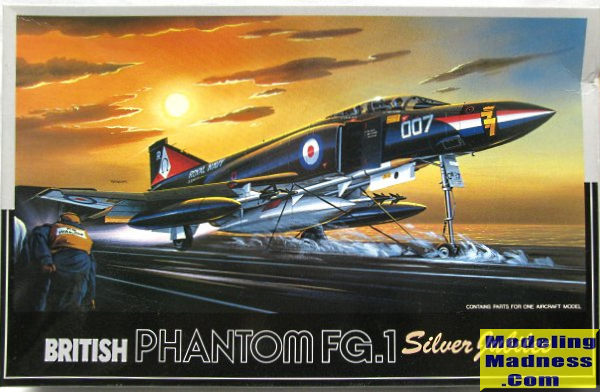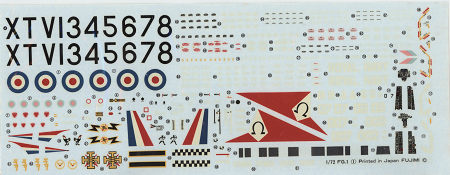
Fujimi 1/72 Phantom FG.1
| KIT #: | 7AH6 |
| PRICE: | 1200 yen when new |
| DECALS: | Three options |
| REVIEWER: | Scott Van Aken |
| NOTES: | 1987 release |

| HISTORY |
The United Kingdom operated the McDonnell Douglas F-4 Phantom II as one of its principal combat aircraft from the 1960s to the early 1990s. The UK was the first export customer for the Phantom, which was ordered in the context of political and economic difficulties around British designs for the roles that it eventually undertook. The Phantom was procured to serve in both the Fleet Air Arm and Royal Air Force in several roles including air defence, close air support, low-level strike and tactical reconnaissance.
Although assembled in the United States, the UK's Phantoms were a special batch built separately and containing a significant amount of British technology as a means of easing the pressure on the domestic aerospace industry in the wake of major project cancellations. Two variants were initially built for the UK: the F-4K variant was designed from the outset as an air defence interceptor to be operated by the Fleet Air Arm from the Royal Navy's aircraft carriers; the F-4M version was procured for the RAF to serve in the tactical strike and reconnaissance roles. In the mid-1980s, a third Phantom variant was obtained when a quantity of second-hand F-4J aircraft were purchased to augment the UK's air defences following the Falklands War.
The Phantom entered service with both the Fleet Air Arm and the RAF in 1969. In the Royal Navy it had a secondary strike role in addition to its primary use for fleet air defence, while in the RAF it was soon replaced in the strike role by other aircraft designed specifically for strike and close air support. By the mid-1970s it had become the UK's principal interceptor, a role in which it continued until the late 1980s, by which time the airframes had reached their life expectancy of 5,000 flight hours and they were retired. In fact, two planes had to have special permission to exceed those hours to be flown to museums.
| THE KIT |
 Back in 1987, Fujimi launched a series of 1/72 F-4s that were much
anticipated and very welcome by the modeling community. Prior to that, the best
in this scale were a pair from Monogram, which released an F-4J and F-4C/D in
1985. Those were and still are quite nice kits, but the rage was engraved panel
lines which Monogram did not have and Fujimi did. Best of all, Fujimi released a
thin wing F-4B/N and a series of British F-4s that, as of this writing, are
still the best around in this scale. Previously, the Spey powered F-4 was poorly
done by Revell and Matchbox, so RAF and FAA Phantom fans really had something to
cheer about.
Back in 1987, Fujimi launched a series of 1/72 F-4s that were much
anticipated and very welcome by the modeling community. Prior to that, the best
in this scale were a pair from Monogram, which released an F-4J and F-4C/D in
1985. Those were and still are quite nice kits, but the rage was engraved panel
lines which Monogram did not have and Fujimi did. Best of all, Fujimi released a
thin wing F-4B/N and a series of British F-4s that, as of this writing, are
still the best around in this scale. Previously, the Spey powered F-4 was poorly
done by Revell and Matchbox, so RAF and FAA Phantom fans really had something to
cheer about.
This is the FAA Phantom FG.1 release that includes the later RWR antenna pod on the top of the fin. I have built several of these British Phantom kits and have enjoyed every one. They are all fairly well done kits that offer no real surprises. One thing I like is that the kits are not a mass of inserts as are the later Hasegawa US/Japanese kit offerings. The cockpit has fair seats and uses decals for the instrument panels and side consoles. It also does not have a proper Navy back seat, an issue with most other F-4 kits. However, it does offer s mask of sorts with pieces that help to block off the rear side consoles. However, those consoles are still there and Fujimi wants you to install a control stick, which you won't find in the nautical versions, though a control stick and rudder pedals can be installed if needed.
It seems that there are certain features of Phantom kits that are the same regardless of which kit you buy. First, the intakes are an inner and outer piece that butts up against the rest of the fuselage. Only Monogram does this a bit differently. The wing is a single lower section out to the folding wing parts with the upper halves containing the outer wing sections. Tailplanes are a single piece that slots into the rear fuselage. Burner cans simply slide into the back of the fuselage and most of us will leave those off until the very end.
Landing gear are nicely molded though the gear wells are rather bare. Fujimi
offers an overextended nose gear for those wanting to do a launch diorama. Main
gear doors will have to be cut apart for an on the ground display. Under the
fuselage are a lot of the usual F-4 options. A centerline and two wing tanks, a
pa ir of dual sidewinder launchers and four Sparrow/Skyflash missiles. A gun pod
is also provided for the centerline. Something I really like is that you have
the option for either a multi-piece open cockpit or a single-piece closed
canopy.
ir of dual sidewinder launchers and four Sparrow/Skyflash missiles. A gun pod
is also provided for the centerline. Something I really like is that you have
the option for either a multi-piece open cockpit or a single-piece closed
canopy.
The instructions are well written and provide Gunze paint references. There are markings for three planes. One is the box art plane from 892 Squadron FAA, with the celebratory 77 on the nose for the queen's silver jubilee. A second is an overall light grey plane from 111Squadron that was used in the Alcock and Brown commemorative flight. The third is a standard 43 Squadron FG.1. Only three units flew the FG.1 and all of them are covered in this boxing. The decals are not exactly pristine, but I've found that even old Fujimi decals will usually be viable.
| CONCLUSIONS |
With the introduction of the new Airfix British Phantom, a number of modelers may well be selling off their Fujimi kits. For most of us, these are still very nice kits and provide superb shelf models. They can usually be found for very reasonable prices and are not fiddly builds. Look for them.
| REFERENCES |
https://en.wikipedia.org/wiki/McDonnell_Douglas_F-4_Phantom_II_in_UK_service
August 2017
Copyright ModelingMadness.com. All rights reserved.
If you would like your product reviewed fairly and
fairly quickly, please
contact
the editor or see other details in the
Note to
Contributors.